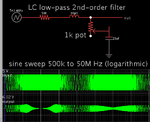s55
Junior Member level 2
I'm looking for a tunable lowpass filter to be used between a signal generator's output and an input of an ADC. Basically, it works as an antialiasing filter.
The desired frequency specifications of this tunable filter are as follws:
start frequency - dc,
stop frequency - 20~50MHz which can be selectively set.
I searched several vendors, but most tunable filters' stop frequencies are few tens kHz. Is there anybody who knows vendors to provide such tunable lowpass filter with the spec as above?
The desired frequency specifications of this tunable filter are as follws:
start frequency - dc,
stop frequency - 20~50MHz which can be selectively set.
I searched several vendors, but most tunable filters' stop frequencies are few tens kHz. Is there anybody who knows vendors to provide such tunable lowpass filter with the spec as above?
